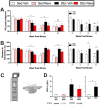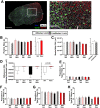An Exercise Mimetic Approach to Reduce Poststroke Deconditioning and Enhance Stroke Recovery
- PMID: 33825581
- PMCID: PMC8135250
- DOI: 10.1177/15459683211005019
An Exercise Mimetic Approach to Reduce Poststroke Deconditioning and Enhance Stroke Recovery
Abstract
Evidence supports early rehabilitation after stroke to limit disability. However, stroke survivors are typically sedentary and experience significant cardiovascular and muscular deconditioning. Despite growing consensus that preclinical and clinical stroke recovery research should be aligned, there have been few attempts to incorporate cardiovascular and skeletal muscle deconditioning into animal models of stroke. Here, we demonstrate in rats that a hindlimb sensorimotor cortex stroke results in both cardiovascular and skeletal muscle deconditioning and impairments in gait akin to those observed in humans. To reduce poststroke behavioral, cardiovascular, and skeletal muscle perturbations, we then used a combinatorial intervention consisting of aerobic and resistance exercise in conjunction with administration of resveratrol (RESV), a drug with exercise mimetic properties. A combination of aerobic and resistance exercise mitigated decreases in cardiovascular fitness and attenuated skeletal muscle abnormalities. RESV, beginning 24 hours poststroke, reduced acute hindlimb impairments, improved recovery in hindlimb function, increased vascular density in the perilesional cortex, and attenuated skeletal muscle fiber changes. Early RESV treatment and aerobic and resistance exercise independently provided poststroke benefits, at a time when individuals are rapidly becoming deconditioned as a result of inactivity. Although no additive effects were observed in these experiments, this approach represents a promising strategy to reduce poststroke behavioral impairments and minimize deconditioning. As such, this treatment regime has potential for enabling patients to engage in more intensive rehabilitation at an earlier time following stroke when mechanisms of neuroplasticity are most prevalent.
Keywords: aerobic exercise; angiogenesis; cardiovascular; resistance exercise; skeletal muscle.
Conflict of interest statement
Figures





Similar articles
-
High-Intensity Interval Training After Stroke: An Opportunity to Promote Functional Recovery, Cardiovascular Health, and Neuroplasticity.Neurorehabil Neural Repair. 2018 Jun;32(6-7):543-556. doi: 10.1177/1545968318766663. Epub 2018 Apr 20. Neurorehabil Neural Repair. 2018. PMID: 29676956 Review.
-
Acute antioxidant supplementation and skeletal muscle vascular conductance in aged rats: role of exercise and fiber type.Am J Physiol Heart Circ Physiol. 2011 Apr;300(4):H1536-44. doi: 10.1152/ajpheart.01082.2010. Epub 2011 Jan 14. Am J Physiol Heart Circ Physiol. 2011. PMID: 21239634
-
Combined Aerobic and Resistance Training for Cardiorespiratory Fitness, Muscle Strength, and Walking Capacity after Stroke: A Systematic Review and Meta-Analysis.J Stroke Cerebrovasc Dis. 2020 Jan;29(1):104498. doi: 10.1016/j.jstrokecerebrovasdis.2019.104498. Epub 2019 Nov 13. J Stroke Cerebrovasc Dis. 2020. PMID: 31732460
-
Muscle activation changes during body weight support treadmill training after focal cortical ischemia: A rat hindlimb model.J Electromyogr Kinesiol. 2011 Apr;21(2):318-26. doi: 10.1016/j.jelekin.2010.09.008. Epub 2010 Oct 18. J Electromyogr Kinesiol. 2011. PMID: 20961773
-
Enhanced Spontaneous Motor Recovery After Stroke in Mice Treated With Cerebrolysin.Neurorehabil Neural Repair. 2021 Jun;35(6):525-533. doi: 10.1177/15459683211000734. Epub 2021 May 6. Neurorehabil Neural Repair. 2021. PMID: 33955296
Cited by
-
How Does Stroke Affect Skeletal Muscle? State of the Art and Rehabilitation Perspective.Front Neurol. 2021 Dec 23;12:797559. doi: 10.3389/fneur.2021.797559. eCollection 2021. Front Neurol. 2021. PMID: 35002937 Free PMC article. Review.
-
Unbiased analysis of mouse brain endothelial networks from two- or three-dimensional fluorescence images.Neurophotonics. 2022 Jul;9(3):031916. doi: 10.1117/1.NPh.9.3.031916. Epub 2022 May 18. Neurophotonics. 2022. PMID: 35620183 Free PMC article.
-
Exercise Mimetics in Aging: Suggestions from a Systematic Review.Nutrients. 2025 Mar 10;17(6):969. doi: 10.3390/nu17060969. Nutrients. 2025. PMID: 40289996 Free PMC article.
-
A modified rehabilitation paradigm bilaterally increased rat extensor digitorum communis muscle size but did not improve forelimb function after stroke.PLoS One. 2024 Apr 11;19(4):e0302008. doi: 10.1371/journal.pone.0302008. eCollection 2024. PLoS One. 2024. PMID: 38603768 Free PMC article.
-
Resveratrol has an Overall Neuroprotective Role in Ischemic Stroke: A Meta-Analysis in Rodents.Front Pharmacol. 2021 Dec 20;12:795409. doi: 10.3389/fphar.2021.795409. eCollection 2021. Front Pharmacol. 2021. PMID: 34987407 Free PMC article. Review.
References
-
- Jeffers MS, Karthikeyan S, Gomez-Smith M, et al.. Does stroke rehabilitation really matter? Part B: an algorithm for prescribing an effective intensity of rehabilitation. Neurorehabil Neural Repair. 2018;32:73-83. - PubMed
-
- MacLellan CL, Keough MB, Granter-Button S, Chernenko GA, Butt S, Corbett D. A critical threshold of rehabilitation involving brain-derived neurotrophic factor is required for poststroke recovery. Neurorehabil Neural Repair. 2011;25:740-748. - PubMed
-
- Murphy TH, Corbett D. Plasticity during stroke recovery: from synapse to behaviour. Nat Rev Neurosci. 2009;10:861-872. - PubMed
Publication types
MeSH terms
Substances
LinkOut - more resources
Full Text Sources
Other Literature Sources
Medical
Research Materials

